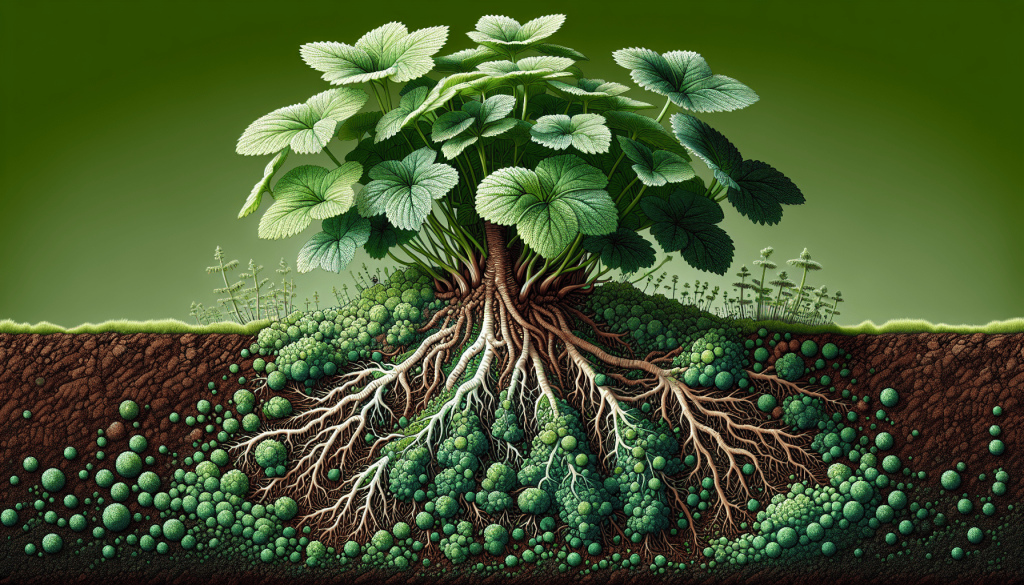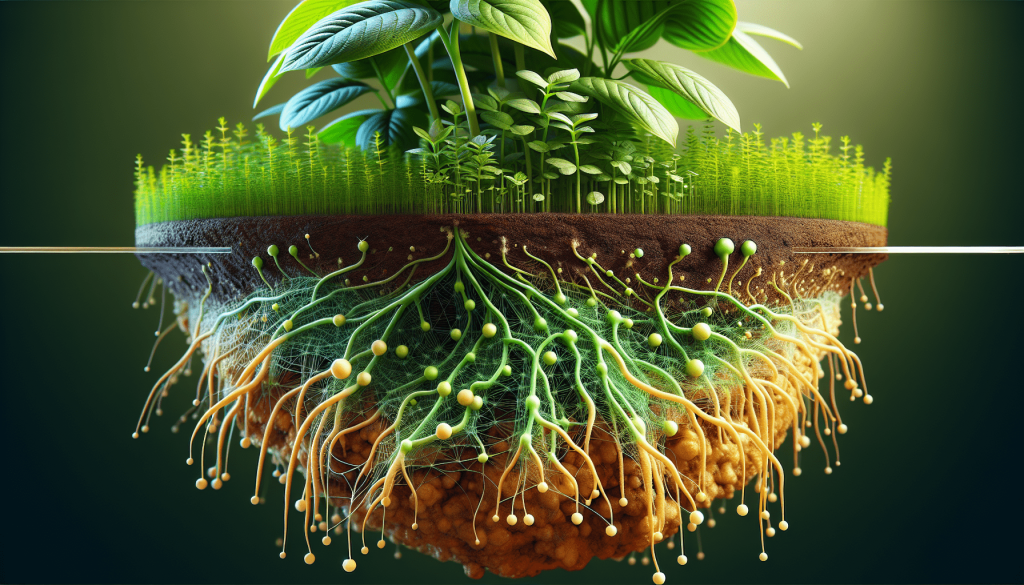This post may contain affiliate links. As an Amazon Associate, we may earn commissions from qualifying purchases.
Mycorrhizal fungi form an essential partnership with your garden plants, significantly boosting their ability to absorb nutrients from the soil. Acting like a vast underground network, these fungi extend far beyond the plant roots, increasing the surface area through which water and nutrients can be absorbed. This collaboration not only enhances the overall health and growth of your plants but also fortifies them against diseases and harsh environmental conditions. As a gardener, you can encourage the presence of these beneficial fungi by minimizing soil disturbance, avoiding excessive use of chemical fertilizers, and incorporating organic matter like compost into your garden beds. By fostering a healthy soil ecosystem, you’ll be well on your way to cultivating a thriving, vibrant garden.
What Is The Role Of Mycorrhizal Fungi In Enhancing Plant Nutrient Uptake, And How Can Gardeners Promote Their Presence In The Soil?
Have you ever wondered how some plants seem to thrive effortlessly while others struggle despite your best efforts? The secret ingredient might be something you can’t see with the naked eye—mycorrhizal fungi. These beneficial fungi form symbiotic relationships with plants, significantly enhancing their nutrient uptake.
In this article, we’ll explore the fascinating role of mycorrhizal fungi in plant nutrition and offer practical tips for gardeners on how to promote their presence in the soil. By the end of this read, you’ll be well-equipped to give your plants a natural boost!

What Are Mycorrhizal Fungi?
To start with, let’s break down what mycorrhizal fungi actually are. The term “mycorrhiza” derives from the Greek words “myco,” meaning fungus, and “rhiza,” meaning root. Essentially, these fungi form a mutualistic relationship with plant roots. The fungi benefit by receiving carbohydrates produced by the plant through photosynthesis, while the plant gains enhanced access to vital nutrients in the soil.
Types of Mycorrhizal Fungi
There are primarily two types of mycorrhizal fungi that are most commonly known: Ectomycorrhizae and Endomycorrhizae (or Arbuscular Mycorrhizae).
| Type | Characteristics | Commonly Found in |
|---|---|---|
| Ectomycorrhizae | Form a sheath around plant roots; extend hyphae into the soil | Trees like pines, oaks, and birches |
| Endomycorrhizae | Penetrate plant root cells, form arbuscules and vesicles within the root cells | Most herbaceous plants, crops like wheat, maize, and soybeans |
How Mycorrhizal Fungi Enhance Plant Nutrient Uptake
You might be asking, “How exactly do these fungi help plants absorb nutrients?” Here’s the magic.
Extending Root Systems
The most obvious benefit of mycorrhizal fungi is the extension of the plant’s root system. Imagine if your plants had a network of miniature tunnels that could access remote corners of the soil, picking up nutrients and bringing them back to the plant roots. That’s essentially what mycorrhizal fungi do.
Increasing Nutrient Availability
These fungi are especially adept at scavenging phosphorus, a nutrient often locked in soil particles, making it inaccessible to plant roots. Mycorrhizal fungi convert these into soluble forms that plants can absorb.
Enhancing Water Uptake
Not only do these fungi help in nutrient uptake, but they also aid in water absorption. In times of drought, plants with mycorrhizal associations fare better than those without.
Producing Growth-Enhancing Compounds
The fungi can also produce compounds that stimulate plant growth. Hormones like auxins and gibberellins, produced by mycorrhizal fungi, can promote root and shoot development.
Benefits Of Mycorrhizal Associations
Now that we’ve covered the basic principles, let’s delve into some of the specific benefits that mycorrhizal associations bring to plants and, by extension, to your garden.
Improved Soil Structure
Mycorrhizal fungi produce glomalin, a glycoprotein that helps in improving soil structure. Good soil structure improves aeration, water infiltration, and root penetration, all of which are crucial for plant health.
Enhanced Disease Resistance
Plants associated with mycorrhizal fungi tend to be more resistant to soil-borne pathogens. The fungi can form a physical barrier around the roots, making it harder for harmful organisms to cause infections.
Efficient Nutrient Cycling
These fungi play a key role in nutrient cycling by breaking down organic matter, which improves soil fertility over time. The fungi take up nutrients and release them in plant-friendly forms as they decompose.
Environmental Benefits
Promoting mycorrhizal fungi in your garden can have broader environmental benefits, like reducing the need for chemical fertilizers and improving the soil carbon sequestration.
Ways Gardeners Can Promote Mycorrhizal Fungi
At this point, you might be excited to try fostering these fungi in your garden. Here are practical ways to promote their presence.
Reduce Chemical Use
Excessive use of fertilizers, especially phosphorus, can hinder the growth of mycorrhizal fungi. Opt for organic fertilizers or reduce the overall quantity you use.
Minimize Soil Disturbance
Tilling and other forms of soil disturbance can disrupt the mycorrhizal networks. Try to practice no-till or low-till gardening methods.
Select Mycorrhizal-Friendly Plants
Certain plants are more likely to form mycorrhizal associations. Legumes, for instance, are excellent choices. Consult local planting guides to select suitable mycorrhizal-friendly plants for your region.
Use Mycorrhizal Inoculants
You can buy mycorrhizal inoculants, which are essentially concentrated sources of these fungi. Applying these to your soil or directly to the roots during planting can jump-start their presence in your garden.
Maintain Organic Matter
Mycorrhizal fungi thrive in soils rich in organic matter. Adding compost, leaf litter, or mulch can provide them with the necessary food sources to flourish.
Avoid Overwatering
While it’s important to keep your plants adequately watered, too much water can create anaerobic conditions unfavorable for mycorrhizal fungi. Ensure good drainage and avoid waterlogging your plants.

Common Misconceptions About Mycorrhizal Fungi
Despite the benefits, there are several misconceptions about mycorrhizal fungi that might deter gardeners from promoting them.
Myth: All Plants Benefit Equally
Not all plants form associations with mycorrhizal fungi to the same extent. For example, members of the Brassicaceae family, like cabbage and mustard, generally do not form mycorrhizal associations.
Myth: More Fungi Are Always Better
Adding more mycorrhizal fungi indiscriminately isn’t always beneficial. It’s important to match the right type of fungi to the plants you are growing.
Myth: Mycorrhizal Fungi Replace the Need for Fertilizers
While mycorrhizal fungi improve nutrient uptake, they should not be viewed as a complete replacement for conventional or organic fertilizers.
Practical Steps to Create a Mycorrhiza-Friendly Garden
Here’s a step-by-step guide to help you bring these benefits to your garden.
- Test Your Soil: Begin by testing your soil for basic nutrients and pH levels. Knowing what your soil contains can help tailor your approach.
- Select The Right Plants: Choose plants known to form mycorrhizal associations based on your soil conditions and climate.
- Incorporate Organic Matter: Add compost and organic matter to improve the soil structure and provide a food source for the fungi.
- Apply Mycorrhizal Inoculants: If necessary, introduce mycorrhizal inoculants at planting time. Be sure to follow the manufacturer’s guidelines.
- Mulch Appropriately: Apply mulch to regulate soil temperature and moisture while providing additional organic matter.
- Water Wisely: Water in a way that prevents waterlogging and promotes deep root growth, as excessive moisture can be detrimental to mycorrhizal fungi.
- Monitor and Adjust: Keep an eye on plant health and adjust your practices as needed. If plants aren’t thriving, you may need to reassess your approach or introduce additional organic matter.
Factors That Hinder Mycorrhizal Growth
Understanding what can go wrong is as important as knowing what promotes mycorrhizal fungi. Here are common factors that can inhibit their growth.
High Soil Phosphorus Levels
Excessive phosphorus makes plants less reliant on mycorrhizal fungi for nutrient uptake. This can inhibit fungal colonization.
Soil Compaction
Compact soils reduce aeration and root penetration, making it harder for mycorrhizal networks to establish.
Pesticide Use
Many fungicides will kill beneficial fungi as well as harmful ones. Chemical pesticides may also have indirect negative impacts.
Acidic or Alkaline Soils
Extreme pH levels, either too low or too high, can inhibit fungal growth. Aim for a balanced soil pH between 6.0 and 7.0 for optimal mycorrhizal activity.
Summing Up
Promoting mycorrhizal fungi in your garden can provide a multitude of benefits, from enhanced nutrient uptake and improved soil structure to increased plant resilience against diseases. By understanding the role these fascinating fungi play in plant health, and taking deliberate steps to foster their presence, you can create a thriving, sustainable garden.
So, next time you plan your garden chores, consider how you can create an environment that welcomes these microscopic allies. Your plants will thank you with lush growth, vibrant blooms, and bountiful harvests!
Happy Gardening! 🌱








